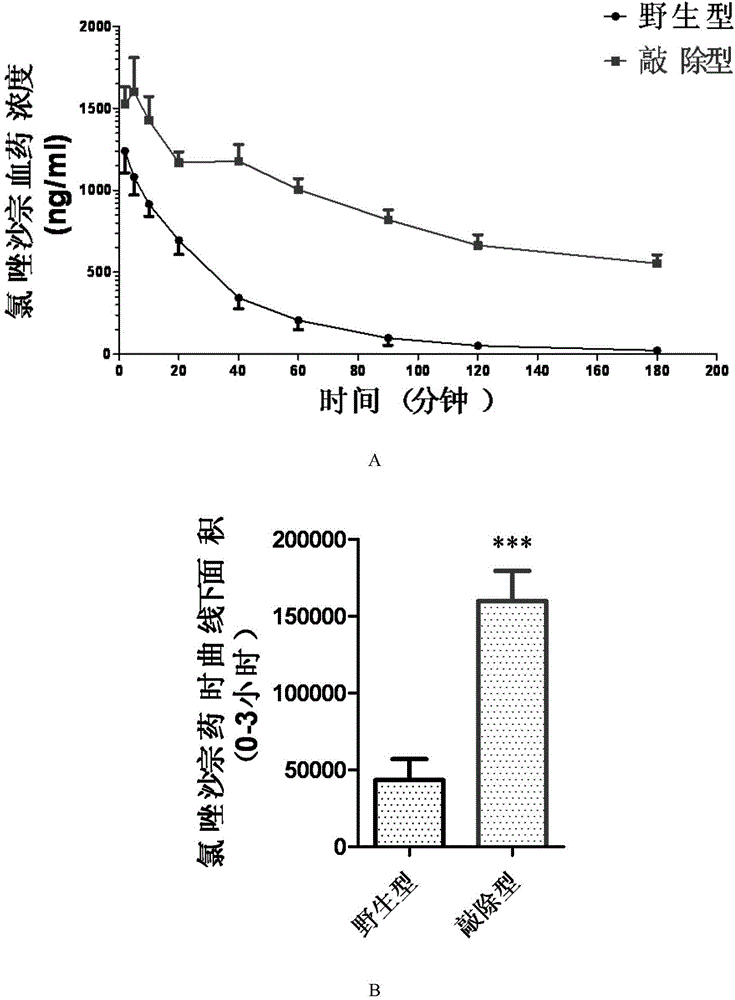Cultivation method of Cyp gene knocked-out rats, and preparation method of liver microsome of the rats
A gene knockout, liver microsome technology, applied in the field of biomedicine, can solve the problems of chemical inhibitors and inhibitory antibodies with reduced selectivity and specificity, inability to predict well, and inability to make accurate judgments, etc.
- Summary
- Abstract
- Description
- Claims
- Application Information
AI Technical Summary
Problems solved by technology
Method used
Image
Examples
Embodiment 1
[0070] Example 1 Target Design and GuideRNA Synthesis
[0071] The CRISPR / Cas gene knockout system can recognize the DNA sequence ending with NGG corresponding to its guide RNA in the genome, so the selected target of the present invention is a 18bp nucleotide at the 5' end of the NGG sequence in the rat target gene acid sequence; because the CRISPR / Cas system for gene knockout utilizes: the introduction of mutated bases in DNA in non-homologous recombination repair, which causes frameshift mutations in the 3' end sequence behind the mutated site, and in order to Therefore, the principle of designing the target in the present invention is to be as close as possible to the 5' end of the full length of the gene; and because the target sequence designed in the present invention is only 18 bp, the same gene may exist in the rat genome. or similar sequences, so the target designed in the present invention will perform online prediction of off-target effects. The prediction tool use...
Embodiment 2
[0076] Example 2 Synthesis and transcription of sgRNA template
[0077] In order to achieve higher efficiency knockout of target genes in rat fertilized eggs, the present invention uses rat fertilized eggs to co-inject sgRNA and Cas9mRNA. The present invention first synthesizes a 60bp oligonucleotide sequence comprising a T7 promoter sequence and a target sequence; then, a complete sgRNA template sequence is synthesized by overlapping PCR, with a total length of 130bp; the template sequence is synthesized by a T7 in vitro transcription kit Perform in vitro transcription; after extraction with phenol-chloroform, the co-transcription product of the purified target and -sgRNA ligated by overlapping PCR was obtained. The corresponding oligonucleotide sequence of 60bp synthesized by the present invention is as follows:
[0078] Cyp2e1
[0079] GATCACTAATACGACTCACTATAGG AAGCAGATCTATAACAGT GTTTTAGAGCTAGAAAT (SEQ ID NO. 4)
[0080] Cyp3a1
[0081] GATCACTAATACGACTCACTATAGG CAA...
Embodiment 3
[0085] Example 3 Genotype Identification of Cyp Gene Knockout Rats
[0086] In the present invention, offspring rats produced by pseudopregnant mother rats are defined as the F0 generation, and the F0 generation rats are mated with wild-type rats, and the offspring rats produced are defined as the F1 generation. Through genotype identification, the present invention selects heterozygous rats with a single locus deletion in the F1 generation, and the number of missing bases is not an integer multiple of three (that is, two alleles at the same locus, one is a base deletion , one is normal) to perform self-crossing, and define its offspring as F2. Since the F1 generation is heterozygous selfing, the genotypes of the F2 generation may be homozygous wild-type rats, homozygous base deletion rats, and heterozygous rats, and the three types of rats produced in this way have closer Genetic background and smaller individual differences facilitate follow-up research.
[0087]Identifica...
PUM
 Login to View More
Login to View More Abstract
Description
Claims
Application Information
 Login to View More
Login to View More - R&D
- Intellectual Property
- Life Sciences
- Materials
- Tech Scout
- Unparalleled Data Quality
- Higher Quality Content
- 60% Fewer Hallucinations
Browse by: Latest US Patents, China's latest patents, Technical Efficacy Thesaurus, Application Domain, Technology Topic, Popular Technical Reports.
© 2025 PatSnap. All rights reserved.Legal|Privacy policy|Modern Slavery Act Transparency Statement|Sitemap|About US| Contact US: help@patsnap.com



